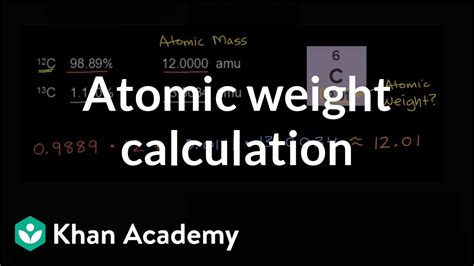How to Find Atomic Weight: A Comprehensive Guide
Finding the atomic weight (or relative atomic mass) of an element might seem daunting, but it's a straightforward process once you understand the underlying concepts. This guide will walk you through several methods, from using a periodic table to understanding the calculations involved.
Understanding Atomic Weight
Before diving into the methods, let's clarify what atomic weight represents. Atomic weight is the average mass of all the isotopes of a particular chemical element, weighted by the abundance of each isotope. It's crucial to remember that it's an average, not the mass of a single atom. This average takes into account the different isotopes and their relative prevalence in nature.
Method 1: Using the Periodic Table
The easiest and most common way to find the atomic weight of an element is by consulting a periodic table. Every entry on the periodic table lists the element's atomic number, symbol, and, crucially, its atomic weight. This value is usually displayed below the element's symbol. Simply locate the element you're interested in, and the atomic weight will be right there.
Example: To find the atomic weight of oxygen (O), look up oxygen on the periodic table. You'll see that its atomic weight is approximately 15.999.
Method 2: Calculating Atomic Weight from Isotopic Abundances
If you need a more precise calculation or are working with data that includes isotopic abundances, you'll need to perform a calculation. This method requires knowing the mass and natural abundance of each isotope of the element.
Formula:
Atomic Weight = (Mass of Isotope 1 x Abundance of Isotope 1) + (Mass of Isotope 2 x Abundance of Isotope 2) + ...
Important Considerations:
- Abundances: Abundances are usually expressed as percentages or decimal fractions (e.g., 75% = 0.75). Ensure consistent units throughout the calculation.
- Masses: Isotope masses are usually given in atomic mass units (amu).
- Significant Figures: Pay attention to significant figures in your calculations to avoid unnecessary precision.
Example: Let's say an element has two isotopes:
- Isotope 1: Mass = 10 amu, Abundance = 60% (0.60)
- Isotope 2: Mass = 12 amu, Abundance = 40% (0.40)
Atomic Weight = (10 amu x 0.60) + (12 amu x 0.40) = 6 amu + 4.8 amu = 10.8 amu
Method 3: Using Online Resources
Several reliable online resources provide atomic weight data. These resources often offer detailed information about isotopes and their abundances. Searching for "[element name] atomic weight" on a search engine like Google will quickly yield relevant results. Remember to verify the reliability of the website you use.
Tips for Success
- Accurate Data: Ensure you're using accurate and up-to-date data. The atomic weights listed on periodic tables are often rounded values.
- Units: Always pay attention to the units used in your calculations.
- Context: Understand that the atomic weight you find might slightly vary based on the source due to the averaging method and isotopic abundance variations.
By following these methods, you can confidently find the atomic weight of any element you need. Remember to choose the method that best suits your needs and the data available to you. Understanding the underlying principles ensures that you're using the atomic weight information appropriately.
